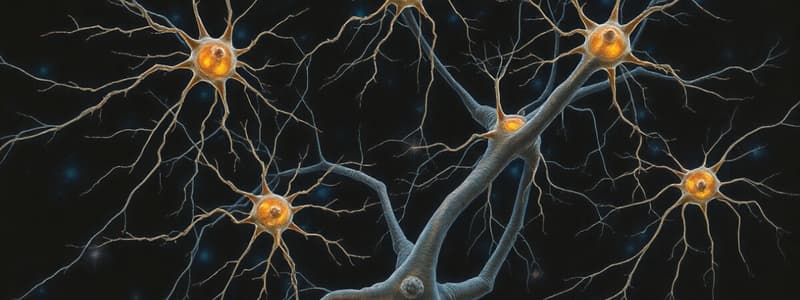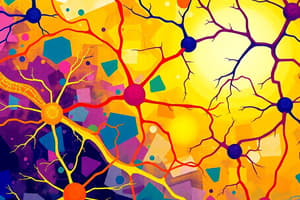Podcast
Questions and Answers
Which of the following sequences accurately describes the direction of signal flow within a single neuron?
Which of the following sequences accurately describes the direction of signal flow within a single neuron?
- Dendrites → Cell body → Axon (correct)
- Axon → Cell body → Dendrites
- Cell body → Dendrites → Axon
- Dendrites → Axon → Cell body
If a neurotoxin specifically targets and destroys oligodendrocytes, which function would be most directly affected?
If a neurotoxin specifically targets and destroys oligodendrocytes, which function would be most directly affected?
- Immune response within the brain.
- Regulation of the chemical environment around neurons.
- Speed of signal transmission along neuronal axons in the CNS. (correct)
- Reception of signals from other neurons.
Which of the following best describes the primary function of neural circuits within the nervous system?
Which of the following best describes the primary function of neural circuits within the nervous system?
- Supporting neurons structurally and metabolically.
- Acting as the brain's immune cells by removing waste and pathogens.
- Integrating information across different brain regions for complex functions.
- Processing information and generating responses. (correct)
Astrocytes play a crucial role in maintaining the neural environment. What is their primary method of achieving this?
Astrocytes play a crucial role in maintaining the neural environment. What is their primary method of achieving this?
What is the critical role of microglia within the central nervous system?
What is the critical role of microglia within the central nervous system?
Which cellular component facilitates communication between different brain regions to perform complex functions like memory and decision-making?
Which cellular component facilitates communication between different brain regions to perform complex functions like memory and decision-making?
The reflex arc is a basic neural circuit. Which of the following represents the correct sequence of neuron activation in a typical reflex arc?
The reflex arc is a basic neural circuit. Which of the following represents the correct sequence of neuron activation in a typical reflex arc?
Which of the following glial cells is primarily responsible for myelinating axons in the peripheral nervous system (PNS)?
Which of the following glial cells is primarily responsible for myelinating axons in the peripheral nervous system (PNS)?
Which of the following ions, when entering a neuron, would most likely cause an inhibitory postsynaptic potential (IPSP)?
Which of the following ions, when entering a neuron, would most likely cause an inhibitory postsynaptic potential (IPSP)?
A drug that blocks acetylcholinesterase would have which of the following effects on synaptic transmission?
A drug that blocks acetylcholinesterase would have which of the following effects on synaptic transmission?
Which neurotransmitter is primarily involved in regulating mood, sleep, and appetite, and is often associated with depression when present at low levels?
Which neurotransmitter is primarily involved in regulating mood, sleep, and appetite, and is often associated with depression when present at low levels?
What is the primary function of the sodium-potassium pump (Na⁺/K⁺ ATPase) in maintaining a neuron's resting membrane potential?
What is the primary function of the sodium-potassium pump (Na⁺/K⁺ ATPase) in maintaining a neuron's resting membrane potential?
In the context of neurotransmitter clearance, which process involves transporter proteins removing neurotransmitters from the synaptic cleft back into the presynaptic neuron?
In the context of neurotransmitter clearance, which process involves transporter proteins removing neurotransmitters from the synaptic cleft back into the presynaptic neuron?
Which of the following neurotransmitters is primarily associated with excitatory neurotransmission in the brain?
Which of the following neurotransmitters is primarily associated with excitatory neurotransmission in the brain?
How do voltage-gated ion channels contribute to the generation and propagation of action potentials in neurons?
How do voltage-gated ion channels contribute to the generation and propagation of action potentials in neurons?
A patient is diagnosed with a neurological disorder characterized by impaired motor control and a lack of motivation. Deficiency in which neurotransmitter is most likely contributing to these symptoms?
A patient is diagnosed with a neurological disorder characterized by impaired motor control and a lack of motivation. Deficiency in which neurotransmitter is most likely contributing to these symptoms?
Which glial cell type in the CNS is characterized by its ability to differentiate into myelin-producing cells and receive synaptic inputs from neurons?
Which glial cell type in the CNS is characterized by its ability to differentiate into myelin-producing cells and receive synaptic inputs from neurons?
What is the primary function of microglia within the central nervous system?
What is the primary function of microglia within the central nervous system?
Ependymal cells line the ventricles of the brain and central canal of the spinal cord. What specialized structure on these cells facilitates the movement of cerebrospinal fluid (CSF)?
Ependymal cells line the ventricles of the brain and central canal of the spinal cord. What specialized structure on these cells facilitates the movement of cerebrospinal fluid (CSF)?
Which of the following best describes the role of the choroid plexus?
Which of the following best describes the role of the choroid plexus?
Dysfunction of ependymal cells can lead to which of the following conditions?
Dysfunction of ependymal cells can lead to which of the following conditions?
During an action potential, which ion primarily moves into the neuron, causing depolarization?
During an action potential, which ion primarily moves into the neuron, causing depolarization?
Which of the following accurately describes the role of potassium (K⁺) ions in neurophysiology?
Which of the following accurately describes the role of potassium (K⁺) ions in neurophysiology?
Considering the functions of microglia, what potential consequence could result from their overactivation in neurodegenerative diseases, such as Alzheimer's?
Considering the functions of microglia, what potential consequence could result from their overactivation in neurodegenerative diseases, such as Alzheimer's?
How do some viruses, such as rabies and herpes, utilize neuronal structures to invade the nervous system?
How do some viruses, such as rabies and herpes, utilize neuronal structures to invade the nervous system?
What is the most significant role of dendritic spines in neuronal function?
What is the most significant role of dendritic spines in neuronal function?
Which of the following components are critical for the function of the Postsynaptic density (PSD)?
Which of the following components are critical for the function of the Postsynaptic density (PSD)?
What is the primary functional distinction between the axon hillock and the initial segment in a neuron?
What is the primary functional distinction between the axon hillock and the initial segment in a neuron?
If a neuron's axon is damaged, disrupting its ability to transmit signals effectively, which glial cells would be involved in the myelination of the regenerating axon segment, and where?
If a neuron's axon is damaged, disrupting its ability to transmit signals effectively, which glial cells would be involved in the myelination of the regenerating axon segment, and where?
How does myelination affect the conduction velocity of action potentials, and what is the underlying mechanism?
How does myelination affect the conduction velocity of action potentials, and what is the underlying mechanism?
Which structural feature of a neuron is most directly responsible for integrating incoming signals and determining whether an action potential will be initiated?
Which structural feature of a neuron is most directly responsible for integrating incoming signals and determining whether an action potential will be initiated?
What is the functional consequence of a neurological disorder that impairs the dynamics (growth and change) of dendritic spines?
What is the functional consequence of a neurological disorder that impairs the dynamics (growth and change) of dendritic spines?
What is the primary role of voltage-gated potassium (K⁺) channels during the repolarization phase of an action potential?
What is the primary role of voltage-gated potassium (K⁺) channels during the repolarization phase of an action potential?
During the absolute refractory period, why is it impossible for a neuron to fire another action potential, regardless of stimulus strength?
During the absolute refractory period, why is it impossible for a neuron to fire another action potential, regardless of stimulus strength?
How do voltage-gated calcium (Ca²⁺) channels contribute to neurotransmitter release at synapses?
How do voltage-gated calcium (Ca²⁺) channels contribute to neurotransmitter release at synapses?
A neuron is currently in its relative refractory period. Which of the following conditions must be met for the neuron to fire another action potential?
A neuron is currently in its relative refractory period. Which of the following conditions must be met for the neuron to fire another action potential?
What is the status of voltage-gated Na⁺ and K⁺ channels when a neuron is at its resting state (-70mV)?
What is the status of voltage-gated Na⁺ and K⁺ channels when a neuron is at its resting state (-70mV)?
How does the inactivation of voltage-gated Na⁺ channels contribute to the action potential?
How does the inactivation of voltage-gated Na⁺ channels contribute to the action potential?
What is the primary function of the refractory period in neurons?
What is the primary function of the refractory period in neurons?
During hyperpolarization, the membrane potential becomes more negative than the resting potential. What causes this?
During hyperpolarization, the membrane potential becomes more negative than the resting potential. What causes this?
In continuous conduction, why is more energy required compared to saltatory conduction?
In continuous conduction, why is more energy required compared to saltatory conduction?
Which of the following best describes the role of myelin in neuronal signal transmission?
Which of the following best describes the role of myelin in neuronal signal transmission?
What is the primary function of synaptic vesicles within a neuron?
What is the primary function of synaptic vesicles within a neuron?
In which type of neuron would you expect to find saltatory conduction?
In which type of neuron would you expect to find saltatory conduction?
Which of the following axons would likely have the fastest conduction velocity?
Which of the following axons would likely have the fastest conduction velocity?
What differentiates dense-core vesicles from synaptic vesicles in neurons?
What differentiates dense-core vesicles from synaptic vesicles in neurons?
How does the diameter of an axon affect the speed of action potential propagation?
How does the diameter of an axon affect the speed of action potential propagation?
Which of the following is the best example of where continuous conduction is typically found?
Which of the following is the best example of where continuous conduction is typically found?
Flashcards
Neuron
Neuron
The fundamental unit of the nervous system that transmits signals.
Parts of a Neuron
Parts of a Neuron
Neurons consist of dendrites, cell body, and axon.
Dendrites
Dendrites
Extensions of neurons that receive signals from other neurons.
Cell Body (Soma)
Cell Body (Soma)
Signup and view all the flashcards
Axon
Axon
Signup and view all the flashcards
Neural Circuit
Neural Circuit
Signup and view all the flashcards
Glial Cells
Glial Cells
Signup and view all the flashcards
Types of Glial Cells
Types of Glial Cells
Signup and view all the flashcards
Dynein
Dynein
Signup and view all the flashcards
Dendritic spines
Dendritic spines
Signup and view all the flashcards
Postsynaptic densities (PSD)
Postsynaptic densities (PSD)
Signup and view all the flashcards
Axon hillock
Axon hillock
Signup and view all the flashcards
Initial segment
Initial segment
Signup and view all the flashcards
Myelin
Myelin
Signup and view all the flashcards
Polydendrocytes
Polydendrocytes
Signup and view all the flashcards
Microglia
Microglia
Signup and view all the flashcards
Ependymal Cells
Ependymal Cells
Signup and view all the flashcards
Cerebrospinal Fluid (CSF)
Cerebrospinal Fluid (CSF)
Signup and view all the flashcards
Hydrocephalus
Hydrocephalus
Signup and view all the flashcards
Ion Movements
Ion Movements
Signup and view all the flashcards
Action Potentials
Action Potentials
Signup and view all the flashcards
Key Ions in Neurophysiology
Key Ions in Neurophysiology
Signup and view all the flashcards
Voltage-Activated Ion Channels
Voltage-Activated Ion Channels
Signup and view all the flashcards
Voltage-Gated Sodium Channels
Voltage-Gated Sodium Channels
Signup and view all the flashcards
Depolarization
Depolarization
Signup and view all the flashcards
Action Potential Peak
Action Potential Peak
Signup and view all the flashcards
Repolarization
Repolarization
Signup and view all the flashcards
Hyperpolarization
Hyperpolarization
Signup and view all the flashcards
Absolute Refractory Period
Absolute Refractory Period
Signup and view all the flashcards
Relative Refractory Period
Relative Refractory Period
Signup and view all the flashcards
Chloride Ion (Cl⁻)
Chloride Ion (Cl⁻)
Signup and view all the flashcards
Calcium Ion (Ca²⁺)
Calcium Ion (Ca²⁺)
Signup and view all the flashcards
Voltage-gated Channels
Voltage-gated Channels
Signup and view all the flashcards
Ligand-gated Channels
Ligand-gated Channels
Signup and view all the flashcards
Sodium-Potassium Pump
Sodium-Potassium Pump
Signup and view all the flashcards
Excitatory Neurotransmitters
Excitatory Neurotransmitters
Signup and view all the flashcards
Inhibitory Neurotransmitters
Inhibitory Neurotransmitters
Signup and view all the flashcards
Neurotransmitter Clearance
Neurotransmitter Clearance
Signup and view all the flashcards
Continuous Conduction
Continuous Conduction
Signup and view all the flashcards
Saltatory Conduction
Saltatory Conduction
Signup and view all the flashcards
Factors Affecting Velocity
Factors Affecting Velocity
Signup and view all the flashcards
Axon Diameter
Axon Diameter
Signup and view all the flashcards
Myelination
Myelination
Signup and view all the flashcards
Vesicles
Vesicles
Signup and view all the flashcards
Synaptic Vesicles
Synaptic Vesicles
Signup and view all the flashcards
Dense-Core Vesicles
Dense-Core Vesicles
Signup and view all the flashcards
Study Notes
Introduction to Neurophysiology
- Neurophysiology is the study of ion movements across a membrane.
- These movements initiate signal transduction and action potentials.
- The study also encompasses neurotransmitters.
Cellular Components of the Nervous System
- Neurons: Fundamental units transmitting electrical and chemical signals.
- Consist of dendrites, cell body, and axon.
- Communicate via electrical impulses and neurotransmitters at synapses.
- Neural Circuits: Functional groups of neurons processing information and generating responses.
- Form the basis of neural activity, from reflexes to complex thoughts.
- Neural Networks: Large-scale interconnected systems of neurons.
- Integrate information across different brain regions.
- Crucial for complex functions like memory, decision-making.
- Glial Cells: Non-neuronal cells providing structural and functional support.
- Types include astrocytes, oligodendrocytes/Schwann cells, microglia, ependymal cells.
- Crucial for maintaining the neural environment, protecting neurons, and aiding signal transmission.
Structure and Mechanisms of a Neuron
- Action Potential: Rapid temporary electrical signal travelling down the axon.
- Steps: resting state, depolarization, repolarization, hyperpolarization, refractory period, return to resting potential.
- All-or-nothing principle: Action potential happens if stimulus reaches threshold otherwise no signals are sent.
- Synapses: Junctions between neurons where communication Occurs.
- Types: Electrical (direct ion flow) and Chemical (neurotransmitters).
- Synaptic cleft: gap (~20-40nm) between pre and postsynaptic neurons.
- Synaptic transmission: Signal moves across cleft via neurotransmitters.
Functional Organization of a Neuron
- Soma (cell body): Contains the nucleus and cytoplasm for cellular functions.
- Perikaryon: Cytoplasm of the soma, excluding the nucleus, critical for protein synthesis.
- Nissl substance: Rough endoplasmic reticulum (RER) and ribosomes, critical for protein synthesis.
- Microtubules: Hollow protein filaments for transport of molecules along the axon.
- Anterograde transport: Movement of molecules from the soma to axon terminals.
- Retrograde transport: Movement of molecules from axon terminals to the soma.
- Dendrites: Treelike extensions receiving signals from other neurons.
- Dendritic spines: Increase surface area and allow for more connections with other neurons, important for learning and memory.
- Axon: Long, cable-like extension transmitting action potentials.
- Axon hillock: Cone-shaped junction where the neuron determines whether to fire an action potential.
- Initial segment: Part of the axon where action potentials are generated.
- Myelin: Fatty insulating sheath speeding up signal transmission by saltatory conduction.
Types of Neurons
- Multipolar neurons: Most common type. Have one axon and multiple dendrites.
- Pseudounipolar neurons: Sensory neurons with one axon that splits into two branches.
- Bipolar neurons: Rare type with one axon and one dendrite.
Types of Synapses
- Axodendritic synapses: Most common, axon synapsing with dendrite.
- Axosomatic synapses: Axon synapsing with cell body of neuron, high influence.
- Axoaxonic synapses: Axon synapsing with another axon, influence neurotransmitter release.
- Temporospatial summation: Neurons summing up inputs from multiple synapses to initiate an action potential.
Types of Glia
- Oligodendrocytes: Produce myelin in the central nervous system.
- Schwann cells: Produce myelin in the peripheral nervous system.
- Astrocytes: Provide structural support, regulate ion balance, control blood flow.
- Microglia: Immune cells of CNS, remove harmful substances.
- Ependymal cells: Produce and circulate cerebrospinal fluid (CSF).
Basic Neurophysiology
- Ion channels and pumps: Crucial for action potential generation (voltage-gated).
- Action potential steps: Resting state, depolarization, repolarization, hyperpolarization, refractory period, return to resting state.
- Refractory periods: Prevent signal overlap.
- Continuous conduction: Unmyelinated axons; slower transmission.
- Saltatory conduction: Myelinated axons; faster transmission.
- Factors influencing velocity: Axon diameter and myelination.
Synaptic Transmission
- Synaptic vesicles: Store neurotransmitters.
- Neurotransmitters: Chemical messengers transmitting signals between neurons.
- Types include excitatory (e.g., glutamate) and inhibitory (e.g., GABA).
- Ionotropic receptors: Fast-acting, directly open ion channels.
- Metabotropic receptors: Slower-acting, activate intracellular signaling cascades.
- Synaptic signal transduction: Excitation and inhibition in postsynaptic neuron.
Neurotransmitters
- Glutamate: Primary excitatory neurotransmitter in the brain
- GABA: Main inhibitory neurotransmitter in the brain.
- Glycine: Primary inhibitory neurotransmitter in the spinal cord.
- Acetylcholine: Used in neuromuscular junctions and brain.
- Biogenic amines (dopamine, serotonin, norepinephrine, histamine): Involved in various functions like mood, movement, and alertness.
- ATP: Plays a role in synaptic modulation.
- Neuropeptides (substance P, endorphins, enkephalins, oxytocin, neuropeptide Y): Longer-lasting effects influencing various functions.
Studying That Suits You
Use AI to generate personalized quizzes and flashcards to suit your learning preferences.





